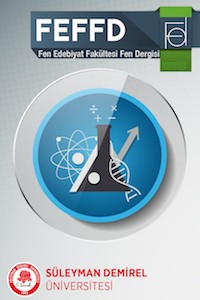Bazı Yarı Deneysel Formüller Kullanılarak 14.5 MeV Civarında Kalay İzotoplarının (n,p) Nükleer Reaksiyonların Tesir Kesitlerinin Hesaplanması
Abstract
Fisyon ve füzyon reaktörlerinin güvenliğinin sağlanabilmesi için kullanılan malzeme ile parçacıklar arasındaki gerçekleşebilecek tüm etkileşimlerin göz önüne alınması gerekmektedir. Nükleer reaksiyonlara ait tesir kesiti verileri; radyoizotop üretimi, radyasyon zırhlama ve malzeme geliştirme çalışmaları olmak üzere oldukça geniş bir alanda kullanılmaktadır. Bu çalışmada, günümüz teknolojilerinde pek çok alanda kaplama malzemesi olarak kullanılan kalay elementinin füzyon reaktörlerinin zırhlamalarına ait nötronik radyasyon etkileri araştırılmıştır. 112-124Sn hedef çekirdek izotopları için 14.5 MeV yüksek gelme enerjili nötronlarla oluşturulan (n,p) reaksiyonlarına ait tesir kesitleri literatürdeki yeni geliştirilmiş yarı deneysel formüller kullanılarak hesaplanmıştır. Yarı ampirik teorik formüllerden hesaplanan sonuçlar, EXFOR’dan elde edilen deneysel sonuçlar ile karşılaştırılmıştır.
Supporting Institution
Osmaniye Korkut Ata Üniversitesi Bilimsel Araştırma Projeleri Birimi
Project Number
OKÜBAP-2019-PT3-008
Thanks
Bu çalışma Osmaniye Korkut Ata Üniversitesi Bilimsel Araştırma Projeleri (BAP) Destekleme Programı tarafından desteklenmiştir. Proje numarası: OKÜBAP-2019-PT3-008.
References
- [1] M. S. Şadoğlu, “Nötral Kalayın Enerji Seviyeleri Üzerine İzotop Kayma Etkilerinin Hesaplanması”, Sakarya Üniversitesi Fen Bilimleri Enstitüsü, Yüksek Lisans Tezi, Aksaray, 2, 2018.
- [2] EXFOR/CSISRS: Erişim adresi: https://www.nndc.bnl.gov/exfor
- [3] E. Tel, “Study on some structural fusion materials for (n,p) reactions up to 30 MeV energy,” J. Fusion. Energ., 29, 332-336, 2010.
- [4] E. Tel, C. Durgu, N. N. Aktı, and Ş. Okuducu, “Calculations of excitation functions of some structural fusion materials for (n,t) reactions up to 50 MeV energy,” J. Fusion. Energ., 29, 290-294, 2010.
- [5] M. Yigit and A. Kara, “Model-based predictions for nuclear excitation functions of neutron-induced reactions on 64,6668Zn targets,” Nucl. Eng. Technol., 49, 996, 2017.
- [6] A. Kara, T. Korkut, M. Yigit, and E. Tel, “Modelling study on production cross sections of 111In radioisotopes used in nuclear medicine,” Kerntechnik, 80 (3), 270-274, 2015.
- [7] E. Tel, B. Şarer, Ş. Okuducu, A. Aydın, and G. Tanir, “A new empirical formula for 14–15 MeV neutron ınduced (n, p) reaction cross section,” J. Phys. G: Nucl. Part. Phys. 29, 2169–2177, 2003.
- [8] V. N. Levkovskii, “Empirical behavior of the (n, p) cross-section for 14-15 MeV neutrons,” Soviet Phys. Jetp, 18, 213, 1964.
- [9] I. Kumabe and K. Fukuda, “Empirical formulas for 14-MeV (n, p) and (n, α) cross sections,” J. Nucl. Sci. Technol., 24 (10), 839-843, 1987.
- [10] C. Konno, Y Ikeda, K. Osihi, K. Kawede, H. Yamomoto, and H. Maekawa, Jaerı-1329, Japan Atomic Energy Research Institute, 1993.
- [11] Y. Kasugai, Y. Ikeda, H. Yamamoto, and K. Kawade, “Systematics of activation cross-sections for 13.4-15.0 MeV neutrons,” JAERI-Conf. 95-008, 1995.
- [12] S. Ait Tahar, “The systematic of (n,p) cross section for 14 MeV neutrons,” Nucl. Phy., 13, 121-125, 1987.
- [13] R. Doczi, V. Semkova, A. D. Majdeddin, Cs. M. Buczko, and J. Csikai, “Investigations on (n,p) cross sections in the 14 MeV region,” Indc (HUN)– 032, NDS, IAEA, 1997.
Cross Section Calculations of (n,p) Nuclear Reactions on Tin Isotopes Around 14.5 MeV Using Some Semi-Experimental Formulae
Abstract
In order to ensure the safety of fission and fusion reactors, all interactions that may occur between the material used and the particles should be considered. Cross section data of nuclear reactions; are used in a wide range such as radio isotope production, radiation shielding and material development studies. In this study, the neutronic radiation effects of the tin element, which is used as a coating material in many areas in today's technologies, on the shielding of fusion reactors were been investigated. The (n,p) reactions cross sections generated with 14.5 MeV high incident energy neutrons for 112-124Sn target core isotopes were calculated using newly developed semi-empirical formulae in the literature. The results calculated from the semi-empirical formulas were compared with the experimental results obtained from the EXFOR.
Project Number
OKÜBAP-2019-PT3-008
References
- [1] M. S. Şadoğlu, “Nötral Kalayın Enerji Seviyeleri Üzerine İzotop Kayma Etkilerinin Hesaplanması”, Sakarya Üniversitesi Fen Bilimleri Enstitüsü, Yüksek Lisans Tezi, Aksaray, 2, 2018.
- [2] EXFOR/CSISRS: Erişim adresi: https://www.nndc.bnl.gov/exfor
- [3] E. Tel, “Study on some structural fusion materials for (n,p) reactions up to 30 MeV energy,” J. Fusion. Energ., 29, 332-336, 2010.
- [4] E. Tel, C. Durgu, N. N. Aktı, and Ş. Okuducu, “Calculations of excitation functions of some structural fusion materials for (n,t) reactions up to 50 MeV energy,” J. Fusion. Energ., 29, 290-294, 2010.
- [5] M. Yigit and A. Kara, “Model-based predictions for nuclear excitation functions of neutron-induced reactions on 64,6668Zn targets,” Nucl. Eng. Technol., 49, 996, 2017.
- [6] A. Kara, T. Korkut, M. Yigit, and E. Tel, “Modelling study on production cross sections of 111In radioisotopes used in nuclear medicine,” Kerntechnik, 80 (3), 270-274, 2015.
- [7] E. Tel, B. Şarer, Ş. Okuducu, A. Aydın, and G. Tanir, “A new empirical formula for 14–15 MeV neutron ınduced (n, p) reaction cross section,” J. Phys. G: Nucl. Part. Phys. 29, 2169–2177, 2003.
- [8] V. N. Levkovskii, “Empirical behavior of the (n, p) cross-section for 14-15 MeV neutrons,” Soviet Phys. Jetp, 18, 213, 1964.
- [9] I. Kumabe and K. Fukuda, “Empirical formulas for 14-MeV (n, p) and (n, α) cross sections,” J. Nucl. Sci. Technol., 24 (10), 839-843, 1987.
- [10] C. Konno, Y Ikeda, K. Osihi, K. Kawede, H. Yamomoto, and H. Maekawa, Jaerı-1329, Japan Atomic Energy Research Institute, 1993.
- [11] Y. Kasugai, Y. Ikeda, H. Yamamoto, and K. Kawade, “Systematics of activation cross-sections for 13.4-15.0 MeV neutrons,” JAERI-Conf. 95-008, 1995.
- [12] S. Ait Tahar, “The systematic of (n,p) cross section for 14 MeV neutrons,” Nucl. Phy., 13, 121-125, 1987.
- [13] R. Doczi, V. Semkova, A. D. Majdeddin, Cs. M. Buczko, and J. Csikai, “Investigations on (n,p) cross sections in the 14 MeV region,” Indc (HUN)– 032, NDS, IAEA, 1997.
Details
| Primary Language | Turkish |
|---|---|
| Subjects | Metrology, Applied and Industrial Physics |
| Journal Section | Makaleler |
| Authors | |
| Project Number | OKÜBAP-2019-PT3-008 |
| Publication Date | May 27, 2021 |
| Published in Issue | Year 2021 Volume: 16 Issue: 1 |


